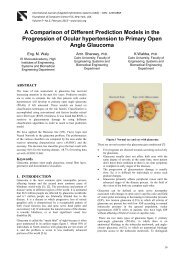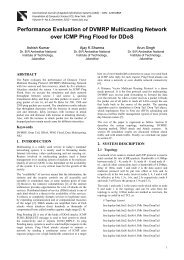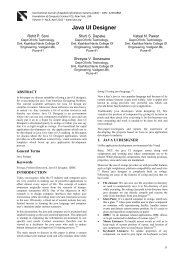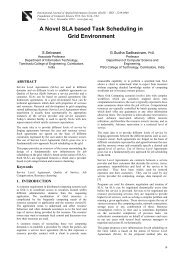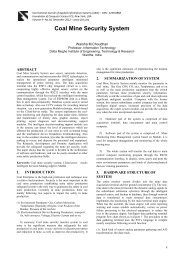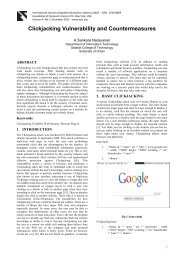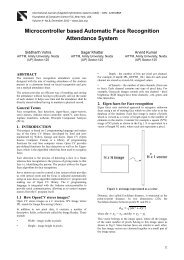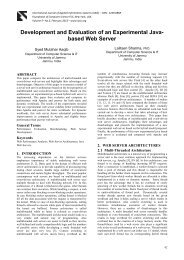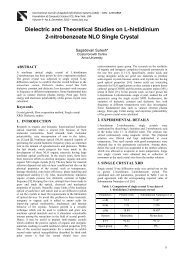Quantifying Aesthetic Parameters of Web Applications - International ...
Quantifying Aesthetic Parameters of Web Applications - International ...
Quantifying Aesthetic Parameters of Web Applications - International ...
Create successful ePaper yourself
Turn your PDF publications into a flip-book with our unique Google optimized e-Paper software.
<strong>International</strong> Journal <strong>of</strong> Applied Information Systems (IJAIS) – ISSN : 2249-0868<br />
Foundation <strong>of</strong> Computer Science FCS, New York, USA<br />
Volume 5– No.6,April 2012 – www.ijais.org<br />
<strong>Quantifying</strong> <strong>Aesthetic</strong> <strong>Parameters</strong> <strong>of</strong> <strong>Web</strong> <strong>Applications</strong><br />
Raj Kulkarni, Ph.D. P.S.R. Patnaik<br />
Walchand Institute <strong>of</strong> Technology Walchand Institute <strong>of</strong> Technology<br />
Solapur University, Solapur University,<br />
Solapur MH India Solapur MH India.<br />
ABSTRACT:<br />
<strong>Web</strong> applications and web sites are integral part <strong>of</strong> day to day life,<br />
most <strong>of</strong> the activities like searching, banking, shopping, paying<br />
utility bills and other activities are carried online through web.<br />
Visual aspects and its aesthetic appeal <strong>of</strong> any web application are<br />
crucial factors to determine the success <strong>of</strong> web applications. In<br />
this paper we study aesthetics factors which form visual appeal <strong>of</strong><br />
a web application to retain its visitors. And develop a tool based<br />
on VIPS algorithm to compute the aesthetic factors <strong>of</strong> web<br />
applications. This study considers prominent factors like layout,<br />
economy, unity, font size, color, proportion, harmony, and variety<br />
to calculate the aesthetic factors computationally. Earlier<br />
evaluations methods for aesthetic factors are either manual or<br />
survey based. This work attempted to compute the aesthetic<br />
factors and score automatically using own developed tool.<br />
Keywords: <strong>Web</strong> <strong>Applications</strong>, VIPS, <strong>Aesthetic</strong> <strong>Parameters</strong>.<br />
1. INTRODUCTION<br />
<strong>Aesthetic</strong>s is the factor which decides the popularity <strong>of</strong> the web<br />
application. <strong>Aesthetic</strong>s also provides a way to decide how the site<br />
will fare in the long run as the predictions <strong>of</strong> web applications are<br />
in done in 30 seconds. It is conclusive that although the criteria by<br />
which people judge visual appearance <strong>of</strong>, user satisfaction and<br />
trustworthiness are not defined, visual appeal which relates to<br />
aesthetics is still a subject <strong>of</strong> study. It is to be noted that<br />
information and search sites would also attempt to communicate<br />
with good visuals. Icons, images are an useful way to<br />
communicate and have more attention grabbing effects on the<br />
users.<br />
David Siegel, who in the book” Creating Killer <strong>Web</strong> Sites” from<br />
1996 argued for the importance <strong>of</strong> aesthetic dimensions, was a<br />
proponent <strong>of</strong> aesthetic <strong>Web</strong> sites. On the other hand The critics<br />
argue it does not matter whether the website was blue or red as<br />
long as it was functional and user-friendly.<br />
<strong>Aesthetic</strong>s play a important role in creating the Image <strong>of</strong> the<br />
organization or the person behind the web application. It is<br />
therefore very imperative that even <strong>Web</strong> <strong>Applications</strong> that mostly<br />
have an information purpose also aesthetically reflect the<br />
organization behind the site.<br />
We have reached an era where the technical and functional<br />
aspects <strong>of</strong> <strong>Web</strong> applications are now defined and finalized .It is<br />
now perceived that the web applications just work perfectly<br />
without any flaws. The technology is viewed as a basic foundation<br />
for aesthetic experiences.<br />
<strong>Aesthetic</strong> is the one <strong>of</strong> the crucial deciding factor for retention <strong>of</strong><br />
visitors on website. There have been several attempts to define<br />
and quantify the aesthetics parameters <strong>of</strong> a website. The six<br />
aesthetics related elements used are balance, equilibrium,<br />
symmetry, sequence, rhythm, as well as order and complexity. We<br />
discuss some <strong>of</strong> aesthetics parameters relevant to websites and<br />
measure them using a VIPS algorithm. In our novel attempt to<br />
quantify the aesthetic aspects <strong>of</strong> website we see very promise able<br />
results.<br />
2. RELATED WORK<br />
There has been lot <strong>of</strong> work carried out in study <strong>of</strong> aesthetics and<br />
its effects on s<strong>of</strong>tware user interfaces. Most <strong>of</strong> the research was<br />
heuristics based. The previous research mostly focused on those<br />
factors <strong>of</strong> aesthetics which are not much pertaining to websites.<br />
Ngo et al comprehensively defined the aesthetics factors and also<br />
formalized various formulas which could quantify the aesthetics<br />
aspects <strong>of</strong> s<strong>of</strong>tware interface and also empirically attempted to<br />
verify the accurateness and correctness <strong>of</strong> the computational<br />
theory <strong>of</strong> evaluating interface aesthetics. Carolyn Salimun[2] et al<br />
worked on six layout principles (Cohesion, Economy, Regularity,<br />
Sequence, Symmetry, and Unity).They found that the layout<br />
principles <strong>of</strong> Symmetry and Cohesion are more influential than<br />
the other layout principles. Similar work to quantify the aesthetic<br />
aspects was made in study <strong>of</strong> artistic aspect <strong>of</strong> s<strong>of</strong>tware and web<br />
interfaces.<br />
A study was conducted by Parizotto-Rebeiro and Hammond [3]<br />
which investigated several Gestalt principles like unity,<br />
homogeneity, proportion, balance, and rhythm. In that results<br />
compared the effect <strong>of</strong> the extent <strong>of</strong> aesthetic presence in each<br />
layout principle (. good unity vs bad unity), but the comparison<br />
did not take in consideration the effect between principles (good<br />
unity vs. good balance)<br />
Lisbeth Thorlacius in its article emphasizes on the role <strong>of</strong><br />
aesthetics in web design [5] discusses the four main areas in<br />
which <strong>Aesthetic</strong>s play an important role in the design <strong>of</strong><br />
successful <strong>Web</strong> sites: aesthetics play an important role in<br />
supporting the content and the functionality, in appealing to the<br />
taste <strong>of</strong> the target audience, in creating the desired image for the<br />
sender, and in addressing the requirements <strong>of</strong> the <strong>Web</strong> site genre.<br />
The author describes his views on the balance <strong>of</strong> functionality and<br />
aesthetics, argues that visual communication through aesthetics is<br />
vital for content perception to users and better aesthetic appeal <strong>of</strong><br />
the website. Hence its quite important to make aesthetic features<br />
<strong>of</strong> website computable.<br />
A tool called BWAIN [6] was developed to artistically interpret a<br />
website correlating website structure with sound and visual art.<br />
Visual aesthetics have been shown to enhance positive user<br />
experience in the context <strong>of</strong> the World Wide <strong>Web</strong> (WWW).<br />
<strong>Aesthetic</strong>s is now center point factor in analysis <strong>of</strong> web<br />
applications. The very first impressions <strong>of</strong> viewing a web site‟s<br />
home page affect a user‟s decision as whether to continue viewing<br />
that web site or move to another one. This decision can be made<br />
in as little as 50 milliseconds mainly because <strong>of</strong> the page‟s visual<br />
appeal [10]. First impressions affect users‟ judgments on different<br />
24
<strong>International</strong> Journal <strong>of</strong> Applied Information Systems (IJAIS) – ISSN : 2249-0868<br />
Foundation <strong>of</strong> Computer Science FCS, New York, USA<br />
Volume 5– No.6,April 2012 – www.ijais.org<br />
aspects <strong>of</strong> web site design including usability, credibility or<br />
purchasing intentions [11].<br />
Recent work by HP Inc fitted Gaussian Model to aesthetic<br />
parameters <strong>of</strong> document layout [12]<br />
3. VISION BASED PAGE SEGMENTATION<br />
(VIPS)<br />
The VIPS algorithm [4] has been developed to extract the<br />
semantic structure for a web page. Segmentation detail is<br />
controlled through the granularity parameter <strong>of</strong> VIPS, which<br />
controls the coherence <strong>of</strong> identified segments based on visual<br />
perception. By using maximum granularity value, this process<br />
aims to identify the smallest possible visual segments, which will<br />
be concatenated through simple heuristics to form the basic<br />
building blocks, such as headers, footers, columns, headings,<br />
paragraphs, tables, images and captions. Such semantic structure<br />
is a hierarchical DOM like structure in which each node will<br />
correspond to a block. Degree <strong>of</strong> Coherence value is assigned to<br />
each extracted block to indicate how coherent <strong>of</strong> the content in the<br />
block based on visual perception.<br />
The VIPS algorithm makes full use <strong>of</strong> page layout feature: it first<br />
extracts all the suitable blocks from the html DOM tree, then it<br />
tries to find the separators between these extracted blocks.<br />
Separators are typically the horizontal or vertical lines in a web<br />
page that visually cross with no blocks or color groupings.<br />
Finally, based on these separators, the semantic structure for the<br />
web page based on its layout, coherence is constructed. Top down<br />
approach and Degree <strong>of</strong> Coherence <strong>of</strong> VIPS algorithm makes it is<br />
very effective for analyzing aesthetic features <strong>of</strong> web page.<br />
Degree <strong>of</strong> Coherence (DoC) is a measure denoting how coherent<br />
it is. DoC has the following properties:<br />
1) The greater the DoC value, the more consistent the content<br />
within the block;<br />
2) In the hierarchy tree, the DoC <strong>of</strong> the child is not smaller than<br />
that <strong>of</strong> its parent.<br />
In VIPS algorithm, DoC values are integers ranging from 1 to 10,<br />
moreover different ranges. Permitted Degree <strong>of</strong> Coherence<br />
(PDoC) is used to achieve different granularities <strong>of</strong> content<br />
structure for different applications. The smaller the PDoC is, the<br />
coarser the content structure would be. Different application can<br />
use VIPS to segment web page to a different granularity with<br />
proper PDoC. Different Selection <strong>of</strong> PDoC values can effectively<br />
be used to analyze aesthetic features [9] namely layout, economy<br />
unity, harmony, variety <strong>of</strong> web page.<br />
The research reported here investigated the relationship between<br />
user preferences <strong>of</strong> the aesthetic design <strong>of</strong> interfaces, based on six<br />
<strong>of</strong> the aesthetics formulae defined by Ngo et. al. [7]]<br />
4. AESTHETIC FEATURES FOR WEB<br />
APPLICATIONS<br />
Layout balance: This measures the spatial distribution <strong>of</strong> visual<br />
element in a webpage. If an element is deemed balanced, viewers<br />
feel a greater sense <strong>of</strong> stability, which in turn contributes to<br />
feelings <strong>of</strong> cohesion and equilibrium. Visual elements seem to<br />
have a „weight‟ which depends on distance from a central point<br />
and the relative distance to other elements which VIPS handles<br />
effectively.<br />
Color Balance: Conveys the average spatial distribution <strong>of</strong> colors<br />
used across data visualization. Instead <strong>of</strong> determining whether<br />
pixels are belonging to the foreground or the background, Color<br />
Balance represents how colors are distributed over the visual<br />
element.<br />
Economy: Metric represents the efficiency <strong>of</strong> the visual artifact<br />
created by the data visualization technique to convey a specific<br />
dataset. In general, aesthetic objects are streamlined, using no<br />
extraneous elements and presented with optimum efficiency [7].<br />
The notion <strong>of</strong> consistency through economy as an aesthetic<br />
principle is supported by the requirement that attractive displays<br />
should “have a properly chosen format and design” [8]. Economic<br />
images contain elements with matching colors and similar sizes,<br />
and so on. If a display is economic, a user feels focused through<br />
the visual simplicity <strong>of</strong> the message; each single element<br />
displayed has a distinct purpose.<br />
Unity: It is considered as a spatial distribution measurement <strong>of</strong><br />
elements. Unity [9] thus conveys how the visualization is<br />
perceived as “a whole” rather than a collection <strong>of</strong> separate parts.<br />
Unity is then determined by the amount <strong>of</strong> “empty” or “unused”<br />
space between graphical elements: the greater this space, the more<br />
separate elements stand out, and the less unified the visualization<br />
is.<br />
Harmony: It is determined by the comparative relationship<br />
between dimensions <strong>of</strong> elements inside the visualization relatively<br />
to each other, and to defined „aesthetic proportions‟ [7]. Displays<br />
that reflect a sense <strong>of</strong> harmonious proportion are deemed as more<br />
attractive [8]. Two different categories <strong>of</strong> aesthetic proportion<br />
aspects are considered, distinguished whether the visualization is<br />
perceived as an individual form, or as a coherent constellation <strong>of</strong><br />
several similar elements.<br />
Variety: Implies the nature and extent <strong>of</strong> novelty which the visual<br />
elements communicate to user. It reflects low predictability in that<br />
a visual element has to be highly informative and rich in content if<br />
the content cannot be easily deduced. Variety as a aesthetic<br />
feature to be optimal is equivalent to high complexity or low<br />
redundancy, is achieved by using a high amount <strong>of</strong> different<br />
elements and distributing these elements equally in the webpage<br />
or image in order to maximize the unpredictability <strong>of</strong> elements<br />
occurring.<br />
5. METHODOLOGY OF QUANTIFYING<br />
THE AESTHETIC FEATURES OF WEB<br />
APPLICATION<br />
5.1. Symmetry<br />
VIPS algorithm obtains the blocks by segmenting the page<br />
visually. We see the balance <strong>of</strong> subtree obtained as a measure <strong>of</strong><br />
symmetry.<br />
<strong>Web</strong>app VIPS<br />
Color<br />
Economy + Unity<br />
Proportion<br />
Harmony + Variety<br />
Layout<br />
extraction and<br />
computation<br />
Overall score<br />
computation<br />
Figure 1 : Overview <strong>of</strong> <strong>Aesthetic</strong> Computation Tool<br />
We associate a value 1 if there exists symmetry at specific level <strong>of</strong><br />
VIPS tree and -1 if there isn't symmetry.<br />
Hence The overall symmetry <strong>of</strong> page can be given as<br />
Sym= ∑( S i ) where i denotes the each level <strong>of</strong> VIPS tree.<br />
Score<br />
25
<strong>International</strong> Journal <strong>of</strong> Applied Information Systems (IJAIS) – ISSN : 2249-0868<br />
Foundation <strong>of</strong> Computer Science FCS, New York, USA<br />
Volume 5– No.6,April 2012 – www.ijais.org<br />
If Sym > C then we say that symmetry is exhibited by the specific<br />
page. The constant C is adjusted and determined according the<br />
level <strong>of</strong> segmentation for VIPS algorithm<br />
5.2. Layout<br />
Layout L is a set <strong>of</strong> blocks B i: L = {B 1, ...,B n} and where each<br />
block is defined as a block B is a pair <strong>of</strong> two points pi: B = (p 1,<br />
p 2), the lower left and the upper right corner, a point p is defined<br />
by a pair <strong>of</strong> coordinates x, y: p = (x, y) .<br />
The layout balance <strong>of</strong> a web page is checked by checking the<br />
balance <strong>of</strong> tree obtained from VIPS algorithm. The balance factor<br />
at each level is taken in to account and the overall balance is <strong>of</strong><br />
the page is determined.<br />
5.3. Color Balance<br />
Based on various surveys relating to general human eye response<br />
to cool colors, we argue that background color and overall range<br />
<strong>of</strong> colors used within a web page should be in range <strong>of</strong> cool<br />
colors.<br />
We also take into account the color contrast, which needs to be<br />
normally high, a high color contrast ratios indicates better<br />
reception by the web page user. Also a good contrast ratio<br />
distinguishes the background from foreground thereby increasing<br />
informative nature <strong>of</strong> a particular block on a web page.<br />
5.4. Font size<br />
VIPS algorithm uses a font size and font weight in its<br />
segmentation process, where each block extracted has uniform<br />
URL Layout Economy Unity Font<br />
Size<br />
font size and font weight. We obtain a average font size <strong>of</strong> all<br />
blocks obtained and check if the size is in range <strong>of</strong> 12px to 18px.<br />
If the average font size across all the blocks falls under the range<br />
then we infer that the font size across the web page is aesthetically<br />
enhancing the overall aesthetics <strong>of</strong> web page. The range <strong>of</strong> 12px<br />
to 18px font size is decided as optimal range as based on the most<br />
widely used web page dimensions <strong>of</strong> width 1000px +- 10px.<br />
5.5. Harmony and variety <strong>of</strong> web page<br />
Harmony being good implies good layout and proportion; else it<br />
implies a presence <strong>of</strong> variety in a web page. The proportion <strong>of</strong><br />
web page is determined by the average ratio <strong>of</strong> block width to<br />
block height.<br />
5.6. Categorizing the <strong>Aesthetic</strong> <strong>Parameters</strong><br />
5.6.1. Visible <strong>Parameters</strong><br />
Layout, Color, Font size: These parameters are implicitly visible<br />
to the users and form first impression <strong>of</strong> aesthetic appeal.<br />
5.6.2. Secondary computable parameters<br />
Economy, unity, proposition, harmony and variety: These<br />
parameters are secondary and mostly hidden to users perception at<br />
first look. But they still aid in enhancing visual aesthetic appeal.<br />
Tests: The following table shows actually values extracted and<br />
computed using VIPS algorithm<br />
Color<br />
Choice<br />
Proportion Harmony Variety Score<br />
aia.org/ √ √ √ √ √ X √ √ 7<br />
2011mediocrity.com/ √ X X √ √ √ X √ 5<br />
blastradius.com/ √ √ √ X √ X √ √ 6<br />
newyorker.com/ √ √ √ X √ X √ √ 6<br />
lego.com/en-us/Default.aspx √ X X √ √ X X √ 4<br />
hidden-heroes.net/ √ X X √ √ √ X √ 5<br />
wired.com/threatlevel/ √ √ √ X √ X √ √ 6<br />
marthastewart.com/ √ √ √ X √ X √ √ 6<br />
whatimade.com/ √ √ √ X √ X √ √ 6<br />
speakfromtheheart.com/ √ √ √ X √ X √ √ 6<br />
bharatstudent.com/ √ √ √ √ √ X √ √ 7<br />
iitb.ac.in/ √ √ √ X √ X √ √ 6<br />
isb.edu/isb/index.shtml √ X X √ √ X X √ 4<br />
india.gov.in/ √ X X X √ X X √ 3<br />
rubyhall.com/ √ √ √ √ √ X √ √ 7<br />
iimahd.ernet.in/ √ √ √ √ √ X √ √ 7<br />
axisbank.com/ √ √ √ √ √ X √ √ 7<br />
vodafone.in/pages/index.aspx √ √ √ √ √ X √ √ 7<br />
unipune.ac.in/ √ X X X √ X X √ 3<br />
maharashtra.gov.in/Pages/Hom<br />
e.aspx<br />
√ √ √ X √ X √ √ 6<br />
bsnl.co.in/ √ √ √ X √ X √ √ 6<br />
solapur.nic.in/ √ X X √ √ X X √ 4<br />
heromotocorp.com/ √ √ √ √ √ X √ √ 7<br />
mahadiscom.in/ √ √ √ √ √ X √ √ 7<br />
balajiwafers.com/ √ √ √ X √ X √ √ 6<br />
mahadiscom.in/ √ √ √ √ √ X √ √ 7<br />
unipune.ac.in/ √ √ √ X √ X √ √ 6<br />
mahadiscom.in/ √ X X √ √ √ X √ 5<br />
Table 1 : Results computed for various web applications using our tool<br />
26
30<br />
25<br />
20<br />
15<br />
10<br />
5<br />
0<br />
<strong>International</strong> Journal <strong>of</strong> Applied Information Systems (IJAIS) – ISSN : 2249-0868<br />
Foundation <strong>of</strong> Computer Science FCS, New York, USA<br />
Volume 5– No.6,April 2012 – www.ijais.org<br />
(Y axis indicates # <strong>of</strong> sites qualifying the minimum threshold)<br />
Figure 2: Study <strong>of</strong> <strong>Aesthetic</strong> parameters<br />
20<br />
15<br />
10<br />
5<br />
0<br />
Economy<br />
Unity<br />
Font size<br />
Color choice<br />
Proportion<br />
Harmony<br />
Variety<br />
Visible<br />
Secondary<br />
Visible<br />
+Secondary<br />
(Y axis indicates # <strong>of</strong> sites qualifying the minimum threshold)<br />
Figure 3: Study <strong>of</strong> <strong>Aesthetic</strong> parameters Grouped<br />
6. SUMMARY<br />
With the results obtained and having an actual user‟s responses<br />
based on small group survey, we conclude that our attempts to<br />
quantify and measure the aesthetic features <strong>of</strong> web page are very<br />
promisable and satisfactory.<br />
We found that font size affects the visual aspects, proportion is<br />
vital factor for determining overall visual appeal <strong>of</strong> web<br />
applications. Most site concentrated on layout and color choice<br />
which are not sufficient for overall aesthetic appeal.<br />
Also the VIPS algorithm helps us to measure the aesthetic aspects<br />
<strong>of</strong> web page independent <strong>of</strong> the language <strong>of</strong> development <strong>of</strong><br />
website. The VIPS algorithm is successfully able to capture the<br />
some <strong>of</strong> the aesthetic aspects <strong>of</strong> web page based on its heuristics<br />
and rules. We still find a scope to improve the correctness and<br />
accurateness <strong>of</strong> our approach by extending the VIPS algorithm<br />
with other algorithms to extract and model aesthetics present in<br />
webpage to quantify and make them measurable parameters.<br />
7. REFERENCES<br />
[1] <strong>Aesthetic</strong>s, Visual Appeal, Usability and User Satisfaction:<br />
What Do the User‟s Eyes Tell the User‟s Brain? Gitte<br />
Lindgaard, Australian Journal <strong>of</strong> Emerging Technologies and<br />
Society Vol. 5, No. 1, 2007, pp: 1-14<br />
[2] Preference ranking <strong>of</strong> screen layout principles Carolyn<br />
Salimun1, Helen C. Purchase2, David R. Simmons3, Stephen<br />
Brewster4<br />
[3] Parizotto-Rebeiro, R., and Hammond, N. 2005. Does<br />
<strong>Aesthetic</strong>s Affect the User„s Perceptions <strong>of</strong> VLE„s?.<br />
Workshop on motivation and affect in educational s<strong>of</strong>tware.<br />
[4] VIPS: a Vision-based Page Segmentation Algorithm, Deng<br />
Cai ,Shipeng Yu Ji-Rong Wen ,Wei-Ying Ma ,Nov. 1, 2003<br />
Technical Report MSR-TR-2003-79<br />
[5] The Role <strong>of</strong> <strong>Aesthetic</strong>s in <strong>Web</strong> Design, LISBETH<br />
THORLACIUS, Nordicom Review 28 (2007) 1, pp. 63-76<br />
[6] BWAIN Artistic <strong>Web</strong> Interpretation, Linda Huber et al.<br />
[7] Ngo, D.C., L. Teo, L.S. and Byrne, J.G. (2003), Modelling<br />
interface aesthetics, Information Sciences, 152, 25-46.<br />
[8] Tufte, E. R. (2001). The Visual Display <strong>of</strong> Quantitative<br />
Information, Graphics Press, Cheshire<br />
[9] Andrew Vande Moere, Nick Cawthon & Andrea Lau The<br />
Evaluation <strong>of</strong> <strong>Aesthetic</strong> Quality in Data Visualization<br />
(http://gaugedesign.com/pdfs/visual_analytics_final.pdf)<br />
[10] Lindgaard, G., Fernandes,G., Dudek, C. and Brown, J. 2006.<br />
Attention web designers: you have 50 milliseconds to make a<br />
good first impression. Behaviour & Information Technology<br />
25, 2 (Mar. 2004), 115-126.<br />
[11] <strong>Web</strong> Site Optimization 2006. First Impressions Count in<br />
<strong>Web</strong> Design. <strong>Web</strong>site optimization.<br />
DOI=http://www.websiteoptimization.com/speed/tweak/blink/<br />
[12] Ildus Ahmadullin; Niranjan 'amera-Venkata , “Learning<br />
<strong>Aesthetic</strong>s Measure <strong>of</strong> a Document Page Layout From<br />
Designers “ ,HP Laboratories HPL-2012-13.<br />
27



